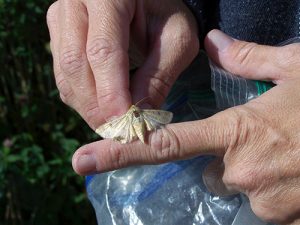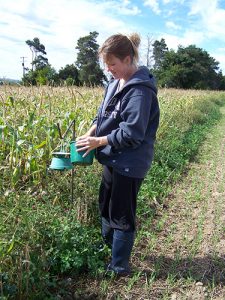Got a sweet tooth for sweetcorn? You’re in good company. So should you hear rumors on the wind about wormy sweetcorn — or field corn or dry beans (the kind you put in your soup kettle) and you’re curious about what’s behind them, here’s the scoop:
The western bean cutworm (just call it “WBC”), a recent invasive, is making waves in the midwestern and eastern corn belts. This pest made landfall in New York’s million-plus acres of field corn in 2010, its numbers spiraling ever upward since. This year, though, has been a record-breaker. WBC has become a pest we can count on for a long time to come.
To cope with WBC, the New York State IPM Program coordinates a “pheromone trap network” for WBC in field corn; in dry beans too. A second IPM trap network focuses on sweetcorn, though it also traps for WBC in beans.
But what is a pheromone and how does the network work? Think of pheromones as scents that insects send wafting on the wind to alert others in their tribe that something important is happening — and the time to act is now. In this case, pheromones are the “come hither” perfumes female moths use to advertise for mates.

But lures imbued with chemical replicates of pheromones can intercept males on their quest, dooming them to a very different fate. IPM scouts strategically place special trap buckets around corn and bean fields. Each contains a “kill strip” treated with an insecticide. Farmers, Extension educators, and crop consultants check the buckets each week to count their take.
And though it’s their larvae — the worms — that give WBC its name, here we’re counting the adults; in this case, moths.

This year the two networks combined have caught more than 35,500 moths — far more than in any other year. Those in the know, know — this is not good. WBC is a sneaky critter. It even eats its eggshells as soon as it hatches, removing evidence that it’s out and about. Meanwhile, trap network numbers can vary considerably from county to county; even from farm to farm. Regardless, when armed with counts in their area farmers know when it’s time to ramp up scouting their fields. Because once they’ve reached threshold — the IPM “do-something” point — it’s time to act.
Why wait till a field reaches threshold? Because sprays are expensive — both to the farmers’ bottom line and the environment. Because time is money too; spending it needlessly out on a rig does no favors. Because treating only at need is one very good way to keep all these costs as low as can be.
Because — it’s what IPM is here for.